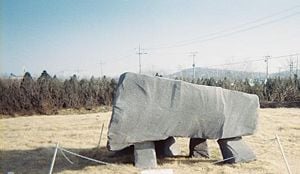Gochang, Hwasun and Ganghwa Dolmen Sites
| Gochang, Hwasun and Ganghwa Dolmen Sites | ||||||||
|---|---|---|---|---|---|---|---|---|
 An example of a go-board/southern-type dolmen on Ganghwa. | ||||||||
| Korean name | ||||||||
|
| Gochang, Hwasun, and Ganghwa Dolmen Sites* | |
|---|---|
| UNESCO World Heritage Site | |
| State Party | |
| Type | Cultural |
| Criteria | iii |
| Reference | 977 |
| Region** | Asia-Pacific |
| Inscription history | |
| Inscription | 2000 (24th Session) |
| * Name as inscribed on World Heritage List. ** Region as classified by UNESCO. | |
Introduction
The Gochang, Hwasun and Ganghwa Dolmen Sites contain hundreds of stone dolmen used as grave markers and for ritual purposes during the first millennium B.C.E. when the Megalithic Culture prevailed on the Korean Peninsula. Designated as a World Heritage Site by UNESCO in 2000, the sites an abundance of dolmen sites. Korea contains more than 40% of the worlds dolmen, mostly concentrated in the Gochang, Hwasun, and Ganghwa sites.
The megalithic stones mark the graves of the ruling elite, making them invaluable sign-posts for archeologists. Pottery, comma-shaped jewels, bronzes, and other funerary artifacts have been excavated from these dolmen. The culture of the people during this time can be gleaned from the evidence left by the dolmen. Additionally, the stones show how stone was quarried, transported, and used to build dolmen.
Dolmen in Korea date to the seventh century B.C.E. in locations such as Gochang. The practice of constructing dolmen ended around the third century B.C.E. The dolmen culture links with the Neolithic and Bronze periods in Korea.
Excavation at the sites began in 1965. Since then, the Korean government has sponsored multiple digs an extensive program of inventory and preservation has been initiated.
Description
Dolmen are generally classified in two types in East Asia. The table/northern-type and the go-board/southern-type. In the former, four stones were positioned to make the walls of a box and were capped by a stone which lay on top of the supports. The latter is characterized by underground burial with stones that supported the capstone.
Gochang Dolmen Site
This group of dolmen are the largest and most varied. They are known as the Jungnim-ri dolmens and are centered in Maesan village. The dolmen were built from east to west at the foot of a series of hills at an altitude of fifteen to fifty meters. Generally, the capstones of the dolmens average around are one to 5.8 meters in length and can weigh ten to 300 tons. 442 dolmen have been documented and classified based on the size of the capstone. This group is believed to have been constructed around the seventh century CE.
Hwasun Dolmen Sites
These dolmen are also located on the slopes of hills and follow the Jiseokgang river. The Hyosan-ri group contains 158 dolmen and the Dasin-ri group, 129. These dolmen are less well preserved than the Jungnim-ri group. The quarry where some of the stones of this group were carved out has been located. This group is dated to around the sixth or fifth century CE.
Ganghwa Dolmen Sites
These dolmen are located on Ganghwa Island. These dolmen are located on the slopes of mountains and are thus higher in elevation than their counterparts. These dolmen are believed to be earliest ones made because the Bugun-ri and Cocheon-ri groups resemble the early dolmen. However, this has not been conclusively proved.
A notable dolmen at Ganghwa is a northern/table-type dolmen where it was believed ancestral rites were performed. It is the biggest stone in South Korea and measures at 2.6 x 7.1 x 5.5 meters.
ReferencesISBN links support NWE through referral fees
- Haeoe Hongbowŏn (Korea). Guide to Korean cultural heritage. Elizabeth, NJ: Hollym 2003. ISBN 9781565912137
- Lee, Gil-sang. Exploring Korean history through world heritage. Seongnam-si: Academy of Korean Studies 2006. ISBN 9788971055519
- Suh, Jai-sik. World heritage in Korea. Elizabeth, NJ: Hollym. 2001. ISBN 9781565911710
External links
- Cultural Heritage Retrieved June 23, 2007.
- Korean National Heritage Online Retrieved June 23, 2007.
- UNESCO Retrieved June 23, 2007.
Credits
New World Encyclopedia writers and editors rewrote and completed the Wikipedia article in accordance with New World Encyclopedia standards. This article abides by terms of the Creative Commons CC-by-sa 3.0 License (CC-by-sa), which may be used and disseminated with proper attribution. Credit is due under the terms of this license that can reference both the New World Encyclopedia contributors and the selfless volunteer contributors of the Wikimedia Foundation. To cite this article click here for a list of acceptable citing formats.The history of earlier contributions by wikipedians is accessible to researchers here:
The history of this article since it was imported to New World Encyclopedia:
Note: Some restrictions may apply to use of individual images which are separately licensed.